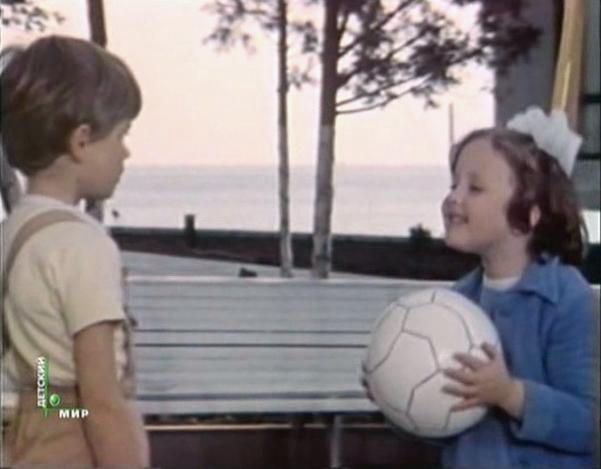
Adventures of the Small Daddy: Ideology

Figure 1.--Thhere was no ideological content in this Soviet film. It was about a boy getting into trouble for playing with a girl. This plpt could just as easily been made in America or Europe. And interestingly the boy from the affluent family was portrayed sympathetically.
|
|
This film is a small low-budget, but it is iteresting on a number of plains, especially ideological considerations. The film deals with an expeience of boyhood across cultures. Pre-teen boys tend to look down on boys who play with girls. Early Soviet films and Stalinist-era films were to a large degree propaganda vehicles. Thus aristocrats and wealthy people were depicted and evil, often cruel peoples. Few nuiances were permitted here. Note that in this film, the "small daddy" was from an affluent family, yet he was depicted in sympathetic terms. Perhaps because his family was not rich in pre-Revolutionary terms, the censors let it pass. We suspect that the censors were becoming less dogmatic. A Russian reader writes, "In the early era ideology was the main point for the Soivet cinema. Lenin wrote, that "Of all arts the most important for us [i.e. Bolsheviks] - it is cinema"E
His point was evidently that in a country with a big proportion of illiterate people, cinema can play the most important role in a propaganda. But after Stalin's death, especially in by the 1970s and 80s Soviet children (and not obly children) movies were totally split up from the ideology. Certainly, there were movies about revolution and civil war, where "red" were always "good boys" and "white" - "bad boys", but even such films became a usual adventure films, so beloved with all children in all countries, with pursuits, fights, secrets and so on (like cowboys and indinans movies in US). And movies about present-day life, like "Adventures of a small Daddy", were totally free from ideology. I note HBC says, "Soviet films and Stalinist-era films were to a large degree propaganda vehicles. Thus aristocrats and wealthy people were depicted and evil, often cruel peoples. Few nuiances were permitted here". This can only be applied only to movies made in 1930s-50s. They really painted wealthy people like fat, cruel, greedy, unfair, cowards, supporters of war and so on. In fact, not only wealth - ANY symbol of the "west-styled" life, for example jazz, considered by Soviet authorities as a threat to "revolutionary ideology". Slogans like "Sevodnya on igraet dzhaz, zavtra Rodinu prodast!" ("Today he plays jazz, tomorrow he will sell his own Motherland") were very widespread. [HBC note: Note the similarity with the NAZIs who also despised jazz.] But, I repeat, later, in 1960s-80s such propaganda vanished totally (even later communist leaders understood that it was too primitive and ineffective)." HBC is unsure that propaganda entirely disappeared from late-Soviet era films, but there were certainly films made wihout ideological content and the ideological content was certainly more nuanced.
HBC

Navigate the Boys' Historical Clothing Web Site:
[Return to the Main "Adventures of a Small Daddy" pagee]
[Return to the Main Aa-Al movie page]
[Return to the Main Russian movie page]
[Introduction]
[Activities]
[Biographies]
[Chronology]
[Clothing styles]
[Countries]
[Bibliographies]
[Contributions]
[FAQs]
[French glossary]
[Images]
[Links]
[Registration]
[Tools]
[Boys' Clothing Home]
Created: 11:21 PM 4/8/2009
Last updated: 11:21 PM 4/8/2009



